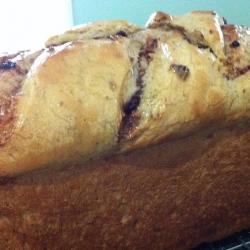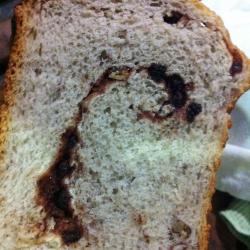
After drooling over sourdough bread while staying at my mother's a long time ago, she handed me this book, told me to read it and assured me if it could be done so long ago with no technology, then I could do it too.

It was just the beginning of a never ending obsession. But I've always kneaded my bread and tended to follow recipes very broadly, if at all and always baked in a tin (my safety net). So I'm new to the stretch and fold, hydration statistics and having lovely big air pockets in my bread consistently. I love to make loaves full of wholesome nutty, chewy goodies and found myself adding this and a little bit of that, but never recording what I had done resulting in some real gems and some shocking horrors you could almost build a house with : )
When I was a child I loved cinnamon, nutmeg and sugar sprinkled on hot toast and fruit and nut loaf without the peel. So using my sourdough I made this loaf . . .

I added roughly chopped pecans, walnuts, cinnamon and nutmeg to the dough (which I kneaded in), then pressed it out gently, spread it with organic rice malt, sprinkled more cinamon, nutmeg, a little brown sugar, nuts and currants and rolled it up ...it was delicious, but dense and way too big... Lot's of improvements to be made as you can see. .. But what I need to know now is .... if I could reproduce the loaf following SourDom's beginner's recipe as a guide, when would it be best to add the nuts to the dough ? I'd really like the crumb to be more open than this one.

I see a post for cinnamon scrolls but I'd really like to be able to toast this for breakfast.
Any ideas would be appreciated.


Replies
Hello Willow,
A technique that I have used for incorporating lumpy bits (particularly fruit for HCBs, fruit loaf etc but also grains etc for multi-grain) is to use the stretch and fold development technique and after the dough has got some development (a couple of S&Fs) incorporate the add-ins in the letter folds.
Stretch your dough out to say A3 size and spread a third of whatever on the middle third and fold the top third down over it and seal the edges. Then another one third on top and fold the bottom third up. Half of the balance on the middle third and fold the left (or right) third over and seal. The rest on top and fold the other third over.
Then do your next couple of S&Fs as normal. Some of the goodies will likely escape but just stuff it back in somewhere. By the time the development is complete the add-ins will be well distributed.
This is particulraly good for soft stuff like fruit that your don't want to crush/smear out. For grains and seeds, by and large, they can be kneaded with the dough and just re-incorporate the refugees that escape.
Keep on bakin'
Farinam
Thanks Farinam - I'll do that. Do you do letter folds from the very beginning ? It looks so in your post 'One way to make a loaf of bread'
My starter is injured and recovering at the moment, so I've been working my way through SourDom's beginners lessons using yeast. I've found that when making the stretch and folds, the dough begins as very elastic but after the third or fourth stretch and fold (in a set of about 10 in sets of ten min intervals) the dough really tightens up and if I keep it up, the dough tears. I'm hoping I can correct this before my starter is ready to use again. Is this because I haven't let it rest long enough ? The end result in the loaves has been irregular splashes of air pockets and mostly at the top, but not like the loaves you make.... maybe using letter folds will improve this ?
... and I've been reading the recipes here for fruit loaf etc and I'm thinking I might adjust Graham's Roast Pumpkin Bread recipe instead of trying to calculate the measurements myself. If I exchange the pumpkin with baked apple, currants, nuts and cinnamon and use oats instead of maize meal and use letter folds as you described, I'm hoping the results will be similar. ... and that way, the flavour should be there, but I won't have to struggle trying to make a roll from such a wet mix. I can try that later when I'm more confident. If you have the time, any suggestions are welcomed ....
Thanks again !
Hello Willow,
I haven't used S&F on yeast bread but I guess you might have to do it more frequently in that case. With sourdough, after the autolyse time, I go straight to S&F at intervals that depend on temperature a bit but are gererally from 45 minutes to one hour. This gives a maximum of four and I find that for the third, the dough is starting to show signs of not wanting to stretch and stay in place. That is, it shrinks back somewhat quite quickly after you stretch it and let it go. At the fourth, this is quite noticeable and a good sign that the dough is well developed. It sounds as if you could be overdoing it a bit on yours.
The letter folds that I refer to are exactly those that I do in the S&F, just that you incorporate the goodies in the process.
When I am shaping a batarde, I stretch/press the dough roughly into a square from a boule that has been placed scrunched side up (tight side down) and then fold in two corners (like the start of a paper aeroplane) pointing away from me and then roll the point so formed back towards me to form a two pointed log. Press the seam together with the heel of your palm and then place seam side up in the banneton to prove. For tinning, fold the points in as you go to keep the ends blunt and place seam side down in your tin to prove.
Good luck with your projects.
Farinam